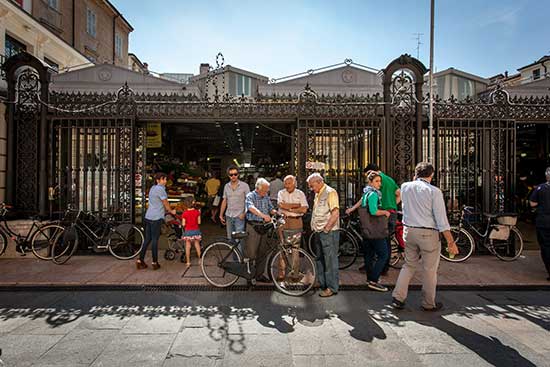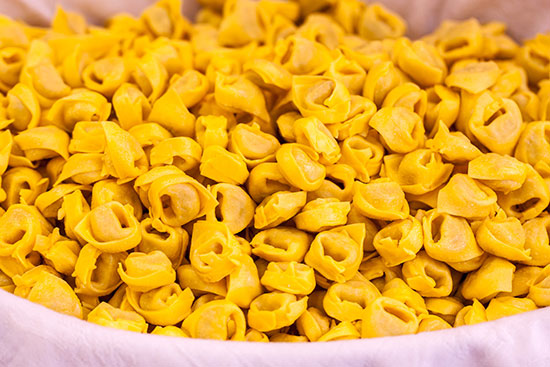今天谈论意大利美食,一定要提到这个小镇

|
摩德纳的美食声名远播,远远超越了这座拥有18.5万居民的小镇。它是马西莫·博图拉的Osteria Francescana餐厅的所在地(这家餐厅经常名列全球最佳餐厅榜单),它手工制作的意大利面在奈飞(Netflix)电视剧《无为大师》(Master of None)第二季中占有重要位置。镇上还有一家比美国历史还悠久的熟食店,出售的熟食和奶酪是本地艾米莉亚-罗马涅大区的饮食珍宝。 在市中心的默卡托·阿尔比内利(Mercato Albinelli),你可以看到当地的烹饪传统得到了最充分的展示。游客们可以在这的彩虹走廊漫步,那有不同品种的樱桃染着深浅不一的红色,有做nocino核桃酒的绿核桃,还有圆圆胖胖的紫茄子。 大约一千年来,摩德纳的市集一直都自发地聚集在附近的格兰德广场(Piazza Grande)上。但在1931年,它搬到了现在的地址,在这座铸铁外墙的新艺术派建筑内,原本非正式的户外市场安置了一个永久正式又令人惊叹的家——这个新家旨在提升城市的现代化水平,提高食品行业的安全和卫生。这座全国历史地标仍然是镇子的烹饪中心,同时也如同画廊一般展示着充满美感的水果、蔬菜、面包、肉类和形状颜色大小各异的意大利面,吸引着游客的到来。 |
Modena’s food reputation looms far larger than the town of 185,000 residents. It’s home to Massimo Bottura’s Osteria Francescana (often listed as among the best restaurants in the world), its handmade pastas featuring prominently in the second season of Netflix’s Master of None. And there is a deli older than America serving up the prized charcuterie and cheeses of parent region Emilia-Romagna. Nowhere is that culinary tradition more on display than at the Mercato Albinelli in the center of town, where visitors can wander its rainbow aisles, brimming with varieties of cherries in every shade of red, green walnuts for nocino, and bulbous purple eggplants. For almost a millennium, Modena’s market was an informal collection of sellers on the nearby Piazza Grande. But in 1931 it moved inside the wrought iron facade of the current Art Nouveau building, giving the casual outdoor market a permanent, formal, and stunning home—one designed to modernize the city as well as improve the safety and hygiene of the food industry. The national historic landmark still serves as the city’s culinary heart while also drawing tourists with its gallery-worthy displays of fruit, vegetables, bread, meat, and pasta in every shape, color, and size. |

|
这里也展示着真正的艺术:市场中心矗立着一个提着水果篮子的小女孩雕像,这座雕塑由摩德纳著名的雕塑家朱塞佩·格拉齐奥西制作。但它可不仅仅是美丽的展示品。雕像的顶部有一个喷泉,可以提供干净的直饮水,室内市场在履行它改善城市生活的使命,这座喷泉是其中微小却重要的一部分。对于那些家里没有干净水源的人而言,这座喷泉就像一个卫生站,有供他们清洗商品的淡水。这是个很小的举动,但却能够表明,这座镇子希望欢迎所有人来参加它的盛宴,大饱眼福,大快朵颐。 纵观整个市场,这种兼具功能性与美学的特点随处可见,卖鱼的摊位上用大块粉红大理石板雕刻的桌子是个突出例子。这种大理石可以把冰块隔开,让鱼保持低温,也方便在每天收摊的时候擦洗干净。鱼贩们把冰块铺在巨大的维罗纳大理石板上,再摆上巨大的章鱼、刚剥了壳的扇贝和半透明的橙虾,展示给往来的客人。玻璃罩后面是海鲈鱼、鱿鱼、蛤蜊、鲭鱼和贻贝,它们放在干净的冰块上,由大理石保持低温。 |
There is also actual art displayed here: At the center of the market stands a statue of a young girl holding a fruit basket, made by Modena’s famous sculptor Giuseppe Graziosi. But the statue is more than just a thing of beauty. It tops a fountain that runs with clean, potable water, a small but important part of the indoor market’s mission to improve city life. For those without clean water at home, this fountain's fresh water provided a sanitary station at which they can wash their produce. It’s a small gesture, but one that shows that the town wants to welcome all comers to its feast for both the eyes and the stomach. Throughout the market, this sort of dual purpose of functional beauty stands out, notably at the giant slabs of pink marble carved into tables that serve as fish counters. The stone insulates the ice to keep the fish cold and wipes clean at the end of every day. Atop the great slabs of Verona marble, the fishmongers spill their ice and stack their display with enormous octopuses, freshly shucked scallops, and translucent orange shrimp. Branzino, squid, clams, mackerel, and mussels sit behind glass shields atop the clean ice, kept cold by the marble. |

|
市场上有65个摊位,包括一家著名的三明治店(Bar Schiavoni)。外面一圈是肉铺,其中一家专门卖马肉。如果你抬头沿着白瓷砖墙面往上看,从挂肉钩的金属栏杆上方再往上,在每个肉铺顶上的角落里,你会看到市场设计中的另外一个巧思:一个小洞。原来,那个洞是一个秘密通道,让每家店铺都能快速方便地进入卫生冷库,而无需占用摊位的空间。 |
There are 65 stalls around the market, including a famous sandwich spot (Bar Schiavoni). Along the outside sit the butcher shops—one of which is specifically for horse meat. And if you look up the white tiled walls, above the metal rail of hooks for hanging meat and up into the upper corner of each butcher shop, you see another of the ingenious designs of the market: a tiny hole. That hole, it turns out, is a secret passage, allowing each of the shops to quickly and conveniently access their sanitary cold storage, without it taking up space in the small stalls. |

|
市场除星期天外,每天都开放,甚至在周五和周六晚上还营业,在65个摊位上,当地特色食物应有尽有:不同年份的帕玛森干酪,本地香醋(与美国生产的糖精仿制品毫无关系),当然少不了fatta a mano面团,这种面团可以手工做出当地著名的意大利饺子(以及长圆饺、馄炖、小方饺、团子等)。熟食店得意地展示着意大利熏火腿,这是当地最著名的特产,但也挂着一架子又一架子的烟肉、干脖肉、烟熏猪里脊、肉肠和六种不同的萨拉米香肠。 最后,一个盛着馅饼的糕点盒里仿佛装了个红绿灯:绿色的甜香草派、亮黄色的柠檬塔还有香脆杏仁挞(sbrisolona)——这种甜品是在传统杏仁蛋糕的基础上加入了能多益(Nutella)巧克力酱和摩德纳本地的樱桃果酱。(财富中文网) 译者:Agatha |
The market is open every day except Sunday and even has evening hours on Fridays and Saturdays, with 65 stalls serving everything from the traditional specialties of the region: various ages of Parmigiano Reggiano cheese, locally aged balsamic vinegar (which has little to do with the saccharine imitations found in the United States), and of course, the pasta fatta a mano, made by hand into the region’s famous tortellini (as well as tortelli, tortelloni, ravioli, gnocchi.) Charcuterie shops show off prosciutto—the region’s best-known specialty—but there’s also shelf after shelf of pancetta, coppa, lonzino, speck, and a half-dozen types of salami. And finally, a pastry case holds a stoplight of tarts: a green sweet herb pie, bright yellow lemon, and a crunchy sbrisolona, a traditional almond cake upgraded with Nutella and tart cherry jam made in Modena. |













